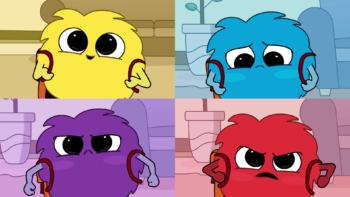
In today’s culture, inclusivity and diversity have become buzzwords, especially around creating content. Too often I see it becoming a box to tick, with little thought being given to an authentic approach to inclusion.
In today’s article I will explain why inclusion is key to the production process, and give you advice on how to ensure that your approach, and the choices you make are genuine.
- A bit about me
- What is inclusivity?
- Invite those with lived experience into the creative process
- Court Services Victoria: Case studies inspired by real life
- Perineal Tears project: Anonymous mothers
- eSafety Commission: Working with Fusion Theatre
- International Women’s Development Agency (IWDA): Inspired by women, performed by women
- Thank you to my clients
A bit about me
My name is Dana Marie Newell, and I am a director and producer who works with my clients to create content that inspires change. As Creativa’s Live-Action Director and Creative Strategist, I have a particular focus on translating difficult conversations for the screen with the intention of teaching or spreading a message.
I work with subject matter experts in all sorts of industries, including government agencies, health organisations, brands, and businesses, and translate challenging topics into video content that engages an audience by drawing out authentic performances and making it entertaining and moving.
What is inclusivity?
Let’s start with getting some of the basic definitions down. When I use the word inclusivity, I do not just mean ensuring we have a diverse representation of talent on screen, but that we are actively creating pathways for people from all backgrounds to be involved in the production process .
In essence, the kind of inclusivity that I am writing about here, and that I practice in my work, is all encompassing and not purely about what, or who, ends up on screen at the end of the project. The inclusivity I am passionate about fostering is one that can change the direction – and the outcome – of a project, simply because we invited the right voices into the conversation.
Invite those with lived experience into the creative process
If you are the producer, director or writer you need to listen to those advising you. And in order to make sure you have the right voices in the conversation, you need to invite feedback and input from those with lived experience.
When my team is in the story development stage, we are inviting these people,with lived experiences, into the creative process. Depending on the project, they could be people who have lived through a similar trauma as the main character, or they could be the same age, or they could have the same skin condition as the audience you want to reach. Life experience is incredibly rich and diverse, and in my experience, can often make or break the impact of the content you are producing.
Without their voice and engagement, that authenticity is lost, and the story, or message, will be lacking. With the story thus impacted, we run the risk of lessening the impact our production has on our audience. .
At Creativa, we produce a lot of content to promote behavioural change. Whether that’s through internal training videos for public facing campaigns. We always have a mixture of Subject Matter Experts and those with lived experiences – helping us navigate the development.
Court Services Victoria: Case studies inspired by real life
We’ve worked with Court Services Victoria for the last couple of years educating their employees about family violence with narrative short films, inspired by real-life case studies. The scripts for these short films are written specially with the intention to help the courts empathise with people coming through the system. Empathy can be difficult to capture on-screen, so we needed to ensure that the stories we told were compelling, authentic, and accurate. This meant working directly with those who were working within the system, putting the narratives through a vigorous feedback process with the court experts.
Perineal Tears project: Anonymous mothers
Including people with lived experience within the narrative lends credibility to your storytelling. We did this when encouraging doctors to empathise with women who are going throughtheir childbirth preparations. We chose a documentary-style approach for this campaign, including interviews with healthcare practitioners, as well as the woman who had experienced perineal tears. However, instead of featuring these women in person, we animated their stories. Given the sensitive nature of the content, the decision to animate was made early in the production process to create a comfortable environment for the women we asked to be involved.
What did this mean for the impact of the videos? Even without seeing the women on-screen, the audience could hear the raw emotion and vulnerability of their stories, and empathise with their experiences.
eSafety Commission: Working with Fusion Theatre
We worked on a series of narrative videos for the eSafety Commision. These videos are used to educate women with cognitive disabilities about the dangers of online and what do if you are feeling bullied or in danger. These stories were inspired by case studies from real women.
I workshopped the stories further with Fusion Theatre, an inclusive community-based theatre company working with people with and without disabilities, and the film’s target audience. This was the part in the processwhere I was able to pull out my acting background experience and, through a series of drama games and improvisational activities, refine the stories into experiencesthat the actors from Fusion Theatre could relate to.
Hiring actors from Fusion Theatre and involving them in in the development of the story really allowed them to connect to the stories and in return, my target audience could relateto them.
International Women’s Development Agency (IWDA): Inspired by women, performed by women
We also had the opportunity to create an animation about the experience of COVID-19 for women in the Asian Pacific region, working with IWDA. This involved months of my client interviewing these women through Facebook chat, email and video chats, where possible. My client provided me with reams of transcripts to mould into a narrative thread. My team then designed animated characters based on photos we were provided to reflect them. As it was impossible to record their own voices (because internet issues and resource acceptability was low), we sourced and hired voice actors in Australia from the same region. So even though the voice overswere performed, they were inspired by real people and represented by women from the same areas. It was no easy feat to find, cast and record these women. But it was well worth the investment of time and resources.
When production companies take the time to invest in authentic story development and production, audiences will be able to resonate with the content on a deeper level and the content has a better chance of provoking change.
Thank you to my clients
I do want to write a particular shout out to the many wonderful clients I have the opportunity to work with; it’s great to see so many of my clients very conscious of the importance of engaging those with lived experience from the very beginning of the production process. It’s something I am looking forward to seeing more and more of from the clients I work with.
So next time you’re producing a video or animation, please consider how the story is being created from the ground up. It’s so important we are maintaining the authenticity and diversity of lived experience.
If you’d like to have a conversation with me about anything I’ve written about here, or about a project that you’ve got in mind, you can book a time to chat here.
I’d love to hear from you.




